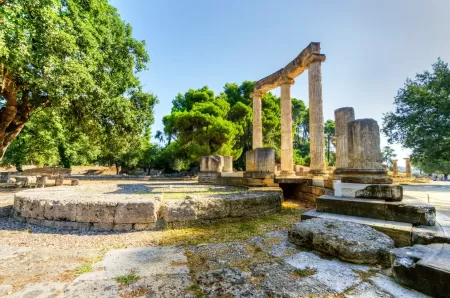Beyond the Acropolis: Your Essential Guide to Athens, Greece
Athens Greece stands as one of the world's oldest cities, with a recorded history spanning over 3,400 years and continuous habitation for at least 5,000 years. When you wander through its streets, you're walking through millennia of civilization that shaped Western culture as we know it today.

Athens, Greece, is one of the world's oldest cities, with a recorded history spanning over 3,400 years and continuous habitation for at least 5,000 years. When you wander its streets, you're walking through millennia of civilization that shaped Western culture as we know it today.
Beyond the iconic Acropolis, this Mediterranean metropolis of approximately 4 million people offers a fascinating blend of ancient wonders and modern urban life. While the city proudly houses two UNESCO World Heritage Sites—the Acropolis of Athens and the Daphni Monastery—it also boasts Europe's largest passenger port in Piraeus. From hosting the first modern Olympic Games in 1896 to staging them again in 2004, Athens has consistently maintained its global significance throughout history.
This guide will take you through the essential things to do in Athens Greece, including world-class museums like the National Archeological Museum with its 5,000-year-old antiquities collection, cultural hotspots, local neighborhoods, and practical travel tips. Whether you're climbing Lycabettus Hill for panoramic views or exploring the vibrant food scene, Athens offers experiences that connect you directly to both its ancient glory and contemporary energy.
Discover Athens and its Wonders with our Greece Tours!

Athens Then and Now: A City of Timeless Layers
Beneath the concrete facade of modern Athens Greece lies a city that has been continuously rebuilt upon itself for millennia. Archaeological evidence reveals human presence in Athens dating back to the 11th and 7th millennia BC, with the oldest known settlement in Athens established around 3000 BC. This remarkable continuity makes the city an unparalleled testament to human civilization's evolution.
The mythological origins of Athens
According to Greek mythology, Athens earned its name through a divine contest. When deciding who would become the city's patron deity, Poseidon and Athena competed for the honor by offering gifts to the Athenians. Poseidon struck the ground with his trident, producing a saltwater spring symbolizing naval power. Athena, however, presented an olive tree, representing peace and prosperity. The citizens, led by King Cecrops I, chose Athena's gift, thereby naming their city after the goddess of wisdom.
This mythological foundation story reflects Athens' historical identity as a center of knowledge and strategic thinking. Furthermore, Athens features prominently in other myths, including the tale of Theseus and the Minotaur, where King Aegeus of Athens tragically drowned in what became known as the Aegean Sea after mistakenly believing his son had perished.
From ancient democracy to modern capital
Athens' political evolution has been remarkably dynamic. In 594 BCE, Solon established laws that laid the groundwork for democracy, but it was Cleisthenes' reforms around 508 BCE that truly established democratic governance. Under Pericles (460-429 BCE), Athens experienced its Golden Age, when the Parthenon was constructed and direct citizen democracy flourished.
Throughout history, Athens has been ruled by various powers—Romans, Byzantines, Ottomans, and others. The city was repeatedly sacked and rebuilt, including destruction by the Persians in 480 BCE, the Heruli in 267 CE, and the Slavs in 582 CE. Despite these challenges, Athens persevered.
After Greece gained independence, Athens was chosen as the capital in 1834, replacing Nafplio. At that time, Athens was merely a modest village of around 7,000 residents clustered near the Acropolis. The first king of Greece, Otto of Bavaria, tasked architects Stamatis Kleanthis and Leo von Klenze with rebuilding the city while preserving its archeological treasures.
How history shapes the city today
In contemporary Athens, you'll witness the fascinating tension between preserving ancient heritage and accommodating modern life. At almost every turn, the past and present intersect visibly. For instance, sitting at a café in central Athens, you can simultaneously view the towering Acropolis and ongoing archeological excavations exposing ruins several meters below modern street level.
The city's growth has often come at the expense of its historical layers. During the 1950s and 1960s, Athens experienced massive population growth when hundreds of thousands of Greeks migrated from rural areas, doubling the population. To address the severe housing crisis, Athenians developed a system called "antiparochi," where contractors would demolish old houses to build apartment blocks, giving homeowners new apartments in exchange. As a result, much of the city's neoclassical architecture disappeared beneath concrete polykatoikies.
Today, archeological considerations factor into every major development project. The construction of Athens' Metro system in the 1990s became a masterclass in balancing progress with preservation. Consequently, many Metro stations now double as archeological museums, showcasing artifacts discovered during excavation.
This ongoing dialogue between past and present makes Athens Greece, uniquely captivating—a city where classical ruins stand alongside buzzing cafés, and ancient pathways underlie modern streets.

Top Things to Do in Athens, Greece
Experiencing Athens Greece, firsthand means immersing yourself in both ancient wonders and vibrant modern culture. The city offers an impressive array of historic sites, charming neighborhoods, and unforgettable vistas that make it truly unique among European capitals.
Visit the Acropolis and Parthenon
No trip to Athens Greece is complete without ascending to the Acropolis, the city's ancient citadel perched dramatically above the modern metropolis. This UNESCO World Heritage site draws approximately three million visitors annually, making it essential to plan your visit strategically. The iconic Parthenon, dedicated to the goddess Athena and built between 448 and 438 BCE, dominates the hilltop with its impressive marble columns and commanding presence.
For the best experience, arrive early in the morning (the site opens at 8 AM) or late afternoon to avoid both crowds and midday heat. Tickets must be booked in advance through the official website as daily visitor numbers are now capped at 20,000. Beyond the Parthenon, explore other significant structures, including the Erechtheion with its famous female caryatid columns and the sacred olive tree that symbolizes Athena's gift to the city.
Explore the Ancient Agora and Roman Forum
The Ancient Agora served as Athens' vibrant heart—where commerce, politics, and social activities flourished. Additionally, this was where Socrates once shared his philosophical ideas. The remarkably preserved Temple of Hephaestus, dating back to the 5th century BC, stands as the most impressive structure within the Agora.
Northeast of the Ancient Agora, you'll find the smaller but historically significant Roman Agora, constructed in the 1st century BC with donations from Julius Caesar and Emperor Augustus. Notable features include the impressive Gate of Athena Archegetis at its western entrance and the octagonal Tower of the Winds (Horologion of Andronicus Kyrrhestus). First thing to remember, a combined ticket grants access to both sites along with several other archeological attractions in Athens.
Stroll through Plaka and Anafiotika
Plaka, Athens' oldest neighborhood, captivates visitors with its cobblestone streets and colorful neoclassical buildings adorned with vibrant bougainvillea. This charming district sprawls at the foot of the Acropolis and houses numerous tavernas, cafés, and boutique shops.
Important to realize, tucked within Plaka is the even more enchanting Anafiotika, a tiny village that feels transported from a Greek island. Built in the 19th century by construction workers from the island of Anafi, this hillside enclave features whitewashed houses with bright blue doors and stunning views. Wandering through these narrow passages offers a magical escape from the bustling city below.
Watch the sunset from Lycabettus Hill
Standing 277 meters above sea level, Lycabettus Hill provides Athens' most breathtaking panoramic views. Notably, this is considered the premier sunset viewing spot in the entire city. As the sun descends, witness Athens bathed in golden light while landmarks like the Acropolis become dramatically illuminated.
You can reach the summit either by hiking up the path (somewhat steep but manageable) or taking the funicular railway. At the peak, visit the 19th-century Chapel of St. George and enjoy refreshments at one of several cafés or restaurants while soaking in views that stretch all the way to the Aegean Sea on clear days.
Experience the changing of the guard at Syntagma Square
The ceremonial changing of the guard in front of the Hellenic Parliament offers a fascinating glimpse into Greek military tradition. Every hour, the Evzones—an elite presidential guard unit—perform this solemn ritual with precisely choreographed, slow-motion movements designed to restore circulation after standing motionless.
For the most impressive display, visit on Sunday morning at 11:00 when the official ceremony features the full uniform. These distinctive outfits hold deep historical significance; the pleated white skirts (fustanella) are said to contain 400 folds representing the 400 years of Ottoman occupation. The guards' distinctive red shoes with black pom-poms weigh three kilos each, emphasizing the physical discipline required for this honorable duty.
Athens for Culture Lovers: Museums, Art, and More
For culture enthusiasts, Athens Greece offers a treasure trove of museums that span thousands of years of human creativity. The city's rich artistic heritage makes exploring its cultural institutions one of the most rewarding things to do in Athens Greece.
National Archeological Museum highlights
The National Archeological Museum stands as Greece's largest museum and one of the world's most significant archeological collections. Housed in an imposing neoclassical building designed by Ernst Ziller, this cultural powerhouse displays over 11,000 exhibits that create a comprehensive panorama of ancient Greek civilization from prehistory through late antiquity.
Among its most remarkable treasures are the gold death mask of Agamemnon from the 16th century BC, the mysterious Antikythera Mechanism (considered the world's first computer), and the impressive bronze statue of Zeus or Poseidon from 460 BC found in a shipwreck off Euboea island. The museum organizes its vast collection into five major permanent collections covering Prehistoric Antiquities, Sculpture Works, Vases, Metalworking Works, and Egyptian Antiquities.
Modern art at the National Museum of Contemporary Art
In stark contrast, the National Museum of Contemporary Art (EMST) showcases cutting-edge works from Greek and international artists. Established in 2000, the museum develops its collections along two main axes: a historic collection dating from the second half of the 20th century and a contemporary collection.
Currently, EMST features exhibitions by artists such as Kasper Bosmans, Sammy Baloji, and Janis Rafa. The museum received a significant boost in 2022 with a donation of 140 contemporary art pieces through the D. Daskalopoulos Collection Gift. Moreover, its impressive video art collection includes works by renowned artists like Bill Viola, Mona Hatoum, and Marina Abramović.
Byzantine and Christian Museum treasures
Equally fascinating, the Byzantine and Christian Museum preserves Greece's medieval heritage through more than 25,000 artifacts dating from the 3rd century AD to the Late Middle Ages. Originally founded in 1914, the museum moved to its current home in the 1848 Ilissia villa.
The exhibits are organized chronologically, guiding you from the ancient world through Byzantium's rise and fall to its lasting influence on modern art. Particularly noteworthy are the early Christian architectural elements, Byzantine jewelry, impressive icons (especially the double-sided ones), and imperial coins representing nearly every Byzantine emperor.
The Acropolis Museum experience
Perhaps Athens' most architecturally striking museum, the Acropolis Museum opened in 2009 and houses over 3,000 artifacts from the Acropolis hill. The museum's three floors culminate in a spectacular top-floor gallery displaying the Parthenon frieze, with plaster casts filling in for pieces currently in the British Museum.
Besides the magnificent Caryatids with their intricate hairstyles and the Parthenon sculptures, don't miss the partially accurate LEGO Acropolis model—perfect for younger visitors. Before leaving, enjoy refreshments at the second-floor restaurant with its breathtaking Acropolis views.

Customize Your Dream Vacation!
Get in touch with our local experts for an unforgettable journey.
Plan Your Trip
Modern Athens: Food, Nightlife, and Local Life
Beyond ancient ruins and world-class museums, modern Athens Greece pulses with a vibrant culinary scene, electric nightlife, and authentic local experiences that offer visitors a taste of contemporary Greek life.
Where to eat: from souvlaki to fine dining
No exploration of Athens Greece feels complete without savoring its iconic street food—souvlaki. This beloved dish, which translates to "spit" or "skewer," has been part of Greek cuisine since the 17th century BC. For outstanding souvlaki experiences, visit O Thanasis in Monastiraki, known for crafting some of the best souvlaki in Athens with their exceptional veal variation. Alternatively, try Aspro Alogo near Plaka for superb pork and chicken skewers.
At the opposite end of the spectrum, Athens boasts impressive fine dining establishments. The city hosts several Michelin-starred restaurants, including Botrini's and Delta, offering creative Mediterranean cuisine. Restaurants like Gallina and Tudor Hall elevate traditional Greek flavors with contemporary techniques and striking Acropolis views.
Best neighborhoods for nightlife
After dark, Athens Greece transforms into one of Europe's most exciting nightlife destinations, with each neighborhood offering a distinctive atmosphere:
- Monastiraki and Syntagma: Perfect for rooftop cocktails beneath the Acropolis at venues like 360 and A for Athens
- Psirri: The urban heart of Athens nightlife featuring hip spots like Tranzistor and Juan Rodriguez Bar
- Gazi: LGBTQ-friendly district filled with bustling nightclubs like Lohan and S-Cape, open until dawn
- Exarchia: The city's alternative neighborhood is ideal for bohemian crowds seeking authentic experiences
Local markets and street culture
To experience authentic Athenian life, visit the laiki agora (people's market). Unlike the central Varvakios market, these lively farmers' markets rotate through different neighborhoods weekly. Starting at dawn, these streets transform as vendors assemble colorful counters filled with seasonal produce, olives, and local specialties. With approximately 195 different laiki markets throughout Athens and Piraeus, they remain an untapped treasure for most tourists. Only the Saturday market on Kallidromiou Street in Exarchia has begun attracting foreign visitors.
Planning Your Trip to Athens
Perfect planning ensures your Athens Greece adventure goes smoothly from ancient ruins to vibrant neighborhoods. To make the most of your trip, consider these essential details before packing your bags.
Best time to visit Athens
Spring (April-May) and fall (September-October) offer the most pleasant Athens experience with mild temperatures ranging from 59°F to 75°F. These shoulder seasons feature fewer crowds and more affordable accommodation rates. Summer months (June-August) bring stifling heat with temperatures often soaring into the 90s and potentially higher. Consider avoiding mid-August when many locals flee to the islands and numerous bars and restaurants close for the holiday. Winter visitors enjoy the lowest hotel prices of the year but should pack for occasional rain, as December averages 2.8 to 3.5 inches of precipitation.
Getting around the city
Athens boasts an affordable, reliable public transportation system covering most of the city and suburbs. The Athens Metro (three lines) runs daily from 5 am to midnight, with Lines 2 and 3 operating until 2 am on weekends. A standard ticket costs €1.20 and remains valid for 90 minutes across all transport modes. For added convenience, the Tap2Ride system allows payment directly with contactless Visa/Mastercard (physical or digital) at validators. The extensive bus and trolleybus network operates from 5 am to midnight, while Airport Express buses run 24 hours. Otherwise, the tram connects central Athens with coastal suburbs like Faliro, Voula, and Piraeus.
Safety tips and local etiquette
Generally, Athens is considered safe for visitors. Above all, exercise common sense—be vigilant with belongings on public transport and avoid displaying valuables openly. Areas requiring extra caution include Omonia, Exarchia, Kolokotroni, and Victoria Square, particularly after dark. Greek driving customs can be hair-raising, so wait a few seconds after pedestrian signals turn green before crossing streets. When visiting religious sites, dress modestly as a sign of respect. Under those circumstances where demonstrations occur, avoid Exarchia and Syntagma Squares.
Day trips from Athens are worth taking
For compelling excursions beyond city limits, consider:
- Delphi (3 hours by bus): Home to the ancient oracle and the "navel of the world"
- Aegina (40 minutes by hydrofoil): Offering ancient ruins, beaches, and world-renowned pistachios
- Ancient Corinth (1 hour 20 minutes by bus): Walk where St. Paul once proclaimed the Gospel
- Nafplio (2 hours 10 minutes by bus): Greece's picturesque former capital with Venetian architecture
- Cape Sounion (2 hours by bus): Perfect for watching spectacular sunsets at the Temple of Poseidon
Conclusion
Athens stands as a remarkable testament to human civilization, where ancient wonders and modern life converge at every corner. Throughout this guide, you've discovered how the city balances its archeological treasures with contemporary energy. Undoubtedly, the iconic Acropolis represents just one facet of this multidimensional metropolis that continues to evolve while honoring its past.
Beyond the spectacular ruins, Athens reveals itself through charming neighborhoods like Plaka and Anafiotika, where traditional architecture and vibrant street life create an authentic Greek experience. Meanwhile, the city's museums offer extraordinary journeys through time, housing priceless artifacts that tell the story of Western civilization's foundations.
The practical aspects of visiting Athens—from navigating public transportation to choosing the ideal season for your trip—ensure you'll make the most of your time exploring this historic capital. During your visit, take advantage of Athens' strategic location as a gateway to other Greek treasures through day trips to Delphi, Nafplio, or the nearby islands.
Perhaps most significantly, Athens demonstrates how a city can simultaneously preserve its ancient heritage while embracing contemporary life. At the end of the day, whether you're watching the sunset from Lycabettus Hill or savoring souvlaki at a neighborhood taverna, Athens offers experiences that connect you directly to thousands of years of human achievement. This unique fusion of past and present makes Athens not just a destination, but rather an essential journey for anyone seeking to understand the foundations of Western culture and witness how classical traditions continue to inspire modern life.
FAQs
Q1. What are some must-visit attractions in Athens besides the Acropolis?
Athens offers numerous attractions beyond the Acropolis. You can explore the Ancient Agora, stroll through the charming neighborhoods of Plaka and Anafiotika, watch the sunset from Lycabettus Hill, or experience the changing of the guard at Syntagma Square. The city also boasts world-class museums like the National Archaeological Museum and the Acropolis Museum.
Q2. How long should I plan to spend at the Acropolis?
A comprehensive visit to the Acropolis typically takes 2-3 hours. This allows enough time to explore the main monuments, appreciate the architecture and history, and take in the panoramic views of Athens. However, if you're particularly interested in ancient history, you might want to allocate more time.
Q3. What's the best time of year to visit Athens?
The ideal times to visit Athens are during spring (April-May) and fall (September-October). These seasons offer pleasant temperatures, fewer crowds, and more affordable accommodation rates. Summer can be quite hot, while winter might bring occasional rain.
Q4. Is Athens safe for tourists?
Athens is generally considered safe for visitors. However, as with any large city, it's important to exercise common sense. Be vigilant with your belongings, especially on public transport, and avoid displaying valuables openly. Some areas like Omonia and Exarchia require extra caution, particularly after dark.
Q5. What are some popular day trips from Athens?
There are several exciting day trips you can take from Athens. Popular options include visiting the ancient oracle site at Delphi, exploring the picturesque former capital Nafplio, or watching the sunset at the Temple of Poseidon in Cape Sounion. For a quick island getaway, you can also take a short ferry ride to Aegina.














